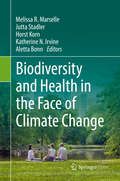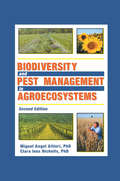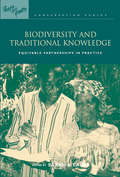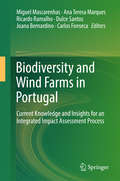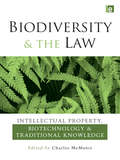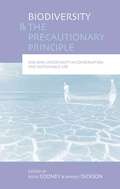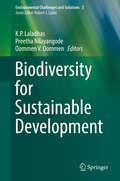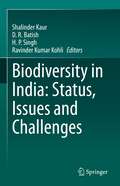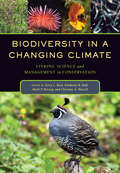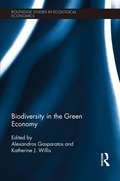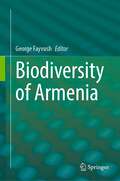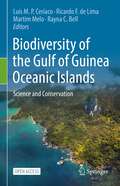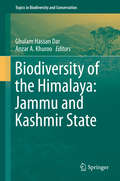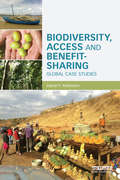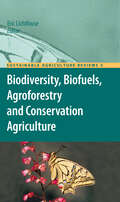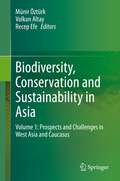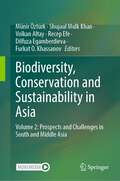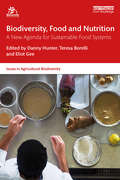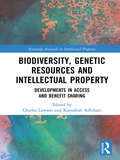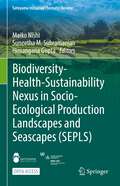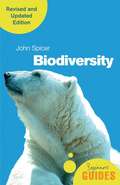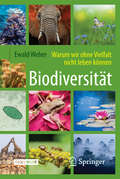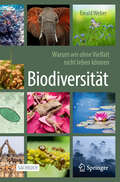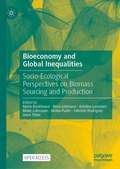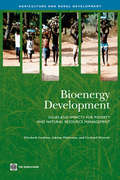- Table View
- List View
Biodiversity and Health in the Face of Climate Change
by Aletta Bonn Horst Korn Jutta Stadler Melissa R. Marselle Katherine N. IrvineThis open access book identifies and discusses biodiversity’s contribution to physical, mental and spiritual health and wellbeing. Furthermore, the book identifies the implications of this relationship for nature conservation, public health, landscape architecture and urban planning – and considers the opportunities of nature-based solutions for climate change adaptation. This transdisciplinary book will attract a wide audience interested in biodiversity, ecology, resource management, public health, psychology, urban planning, and landscape architecture. The emphasis is on multiple human health benefits from biodiversity - in particular with respect to the increasing challenge of climate change. This makes the book unique to other books that focus either on biodiversity and physical health or natural environments and mental wellbeing. The book is written as a definitive ‘go-to’ book for those who are new to the field of biodiversity and health.
Biodiversity and Pest Management in Agroecosystems
by Miguel Altieri Clara NichollsExplore the latest research on biological control! Completely updated for 2004, this new edition examines methods for making agricultural systems less susceptible to insect pests. Containing new findings and reports of strategies, Biodiversity and Pest Management in Agroecosystems, Second Edition will show you how pests can be managed by enhancing beneficial biodiversity using agroecological diversification methods. Biodiversity and Pest Management in Agroecosystems, Second Edition provides you with an essential overview of the role of biodiversity in agriculture and then gets specific, with new and updated information on: the agroecology of pest management plant diversity and pest outbreaks within agroecosystems diversification strategies for pest management how sustainable farming systems are designed You'll also explore: the role of plant diversity on the biology of beneficial insects insect regulation in diverse agroecosystems manipulation of plant diversity in agroecosystems ecological and socioeconomic implications The fact is, many modern agroecosystems are unstable as a consequence of constant human intervention in crop systems which ignore ecological principles. With case studies on a variety of crops and pests, Biodiversity and Pest Management in Agroecosystems, Second Edition explores entomological aspects of agriculture and analyzes the ecological basis for the maintenance of biodiversity. It will familiarize you with the theory and practice of enhancing biological pest control in agricultural systems by managing vegetational diversity via multiple cropping, cover cropping, rotations, and other spatial and temporal designs. With studies on intercropping, cover cropping, weed management, and crop-field border vegetation manipulation, this book covers the effects of these diverse systems on pest population density and the mechanisms underlying pest reduction in polycultures. Make it a part of your reference/teaching collection today!
Biodiversity and Traditional Knowledge: Equitable Partnerships in Practice (People And Plants International Conservation Ser.)
by Sarah A. LairdBiodiversity research and prospecting are long-standing activities taking place in a new legal and ethical environment. Following entry into force of the Convention on Biological Diversity in 1993, and other recent policy developments, expectations and obligations for research and prospecting partnerships have changed. However, to date there are few guides to integrating these concepts with practice. This book offers practical guidance on how to arrive at equitable biodiversity research and prospecting partnerships. Drawing on experience and lessons learned from around the world, it provides case studies, analysis and recommendations in a range of areas that together form a new framework for creating equity in these partnerships. They include researcher codes of ethics, institutional policies, community research agreements, the design of more effective commercial partnerships and biodiversity prospecting contracts, the drafting and implementation of national 'access and benefit-sharing' laws, and institutional tools for the distribution of financial benefits. As part of the People and Plants initiative to enhance the role of communities in efforts to conserve biodiversity and use natural resources sustainably, Biodiversity and Traditional Knowledge will be invaluable to students, researchers and local communities, academic institutions, international agencies, government bodies and companies involved in biodiversity research, prospecting and conservation.
Biodiversity and Wind Farms in Portugal: Current knowledge and insights for an integrated impact assessment process
by Miguel Mascarenhas Ana Teresa Marques Ricardo Ramalho Dulce Santos Joana Bernardino Carlos FonsecaThis book presents a review of the state-of-the-art knowledge on the interactions between biodiversity and wind energy development, focused on the Portuguese reality. The volume addresses the particularities of the impact assessment procedures in Portugal, contrasting it with the international practices and presenting its main findings by covering the following broader themes: i) evaluation of spatial and temporal dynamics of wildlife affected by wind farms, including birds, bats and terrestrial mammals (in particularly Portuguese wolf population); ii) the methodologies used to assess impacts caused by this type of developments in biodiversity; iii) the best practice methodologies to implement an adaptive management approach to reconcile biodiversity and wind farms. The knowledge presented in this book was gathered through the research and development activities developed by Bioinsight company (former Bio3 company) during the last 13 years and partially funded by a R&D project designated as "Integrated solutions for biodiversity management at wind farms: reduce and compensate bird and bat mortality" (acronym: Wind & Biodiversity), co-funded by the European Regional Development Fund (FEDER), under the Regional Operational Programme of Centre (Mais Centro). This volume fills a void in the literature as a book giving insights on the best practices to install and manage a wind farm from a biodiversity management point of view, while establishing a commitment between economic sustainability and biodiversity conservation.
Biodiversity and the Law: "Intellectual Property, Biotechnology and Traditional Knowledge"
by Charles R. McManisHow do we promote global economic development, while simultaneously preserving local biological and cultural diversity? This authoritative volume, written by leading legal experts and biological and social scientists from around the world, aims to address this question in all of its complexity. The first part of the book focuses on biodiversity and examines what we are losing, why and what is to be done. The second part addresses biotechnology and looks at whether it is part of the solution or part of the problem, or perhaps both. The third section examines traditional knowledge, explains what it is and how, if at all, it should be protected. The fourth and final part looks at ethnobotany and bioprospecting and offers practical lessons from the vast and diverse experiences of the contributors.
Biodiversity and the Precautionary Principle: Risk, Uncertainty and Practice in Conservation and Sustainable Use
by Barney Dickson Rosie CooneyGreat uncertainty typically surrounds decisions and management actions in the conservation of biodiversity and natural resource management, and yet there are risks of serious and irreversible harm for both biodiversity and the humans that rely on it. The precautionary principle arguably underlies all international conservation efforts and promotes acting to avoid serious or irreversible environmental harm, despite lack of scientific certainty as to the likelihood, magnitude or cause of harm. This book is the first to examine the application of the precautionary principle to biodiversity conservation and natural resource management, incorporating perspectives from scientists, economists, lawyers and practitioners from both developing and developed countries. It analyses the application and impacts of the principle in many areas including forestry, invasive alien species, wildlife trade, protected areas and fisheries, in a range of national and international contexts. Particular attention is drawn to issues of equity, livelihoods, science and politics, and the book provides guidelines for applying the precautionary principle to biodiversity conservation and natural resource management.
Biodiversity for Sustainable Development (Environmental Challenges and Solutions #3)
by K. P. Laladhas Preetha Nilayangode Oommen V. OommenDivided into three sections, this book explores the three main pillars of sustainable development, namely economy, environment and society, and their interlinkages at the regional level. The first section, Access and Benefit Sharing (ABS) for sustainable development, focuses on international agreements and national legislation, as well as the challenges in implementing ABS in e. g. India. In turn, the second section examines the process of forming Biodiversity Management Committees (BMCs) at the Local Self Government (LSG) level to promote environmental sustainability, highlighting local and community-level conservation initiatives that have led to the conservation of habitats and species. The third section addresses poverty eradication and food security. The case studies included demonstrate how the combination of traditional knowledge and modern techniques can enhance the productivity of traditional crop varieties, yielding greater benefits for communities. The aim of this volume is to disseminate the lessons learned from these case studies, as well as the findings from projects already in place, which can offer recommendations that can be applied to similar problems elsewhere in an attempt to find environmental solutions for sustainable development. Further, it introduces readers to new approaches to inclusive development, demonstrating that participation and grass root empowerment are key drivers of equitable and sustainable development.
Biodiversity in India: Status, Issues and Challenges
by Shalinder Kaur D. R. Batish H. P. Singh Ravinder Kumar KohliThis contributed book is based on the current status of biodiversity in India, issues and challenges faced by the authorities involved in conservation efforts, and the imperative role of various direct and indirect stakeholders in biodiversity conservation. The book discusses the current status of different forms of biodiversity in India, challenges faced by stakeholders, issues and reasons for biodiversity losses, and efforts by government through various laws, policies, and programs in a concise and comprehensive manner throughout its many chapters. In this way, readers can access diverse information on Indian biodiversity through this book. It is compiled by leading experts in the field of conservation. In 18 chapters, it covers biodiversity of both fauna and flora, on land and in aquatic ecosystems, legal and policy aspects, as well as innovative conservation tool and techniques. It is useful for undergraduates and graduate students and also educates policy planners, bureaucrats, foresters, and researchers in India and abroad.
Biodiversity in a Changing Climate
by Kimberly R. Hall Christine A. Howell Mark P. Herzog Terry Louise RootOne major consequence of climate change is abrupt, dramatic changes in regional biodiversity. Even if the most optimistic scenarios for mitigating climate change transpire, the fate of many wild species rests on the shoulders of people engaged in conservation planning, management, and policy. Providing managers with the latest and most useful climate change research is critical and requires challenging the conventional divide between scientists and managers.Biodiversity in a Changing Climate promotes dialogue among scientists, decision makers, and managers who are grappling with climate-related threats to species and ecosystems in diverse forms. The book includes case studies and best practices used to address impacts related to climate change across a broad spectrum of species and habitats--from coastal krill and sea urchins to prairie grass and mountain bumblebees. Focused on California, the issues and strategies presented in this book will prove relevant to regions across the West, as well as other regions, and provide a framework for how scientists and managers in any region can bridge the communication divide to manage biodiversity in a rapidly changing world.Biodiversity and a Changing Climate will prove an indispensable guide to students, scientists, and professionals engaged in conservation and resource management.
Biodiversity in the Green Economy (Routledge Studies in Ecological Economics)
by Alexandros Gasparatos Katherine J. WillisIn the past decade, the growing realization that biodiversity and human wellbeing are inextricably linked has led to the adoption of numerous environmental policies. The concept of the Green Economy has gained particular attention as an economic system where growth is possible within environmental limits. The preservation of ecosystem services and the halt of biodiversity loss are identified as key pillars of the Green Economy. Despite the concept’s momentum there is still no clear understanding of how biodiversity fits within a Green Economy. In the current debate, biodiversity is rarely acknowledged in economic sectors other than agriculture, forestry, fisheries and tourism, and when it is acknowledged biodiversity and its conservation feature more as buzzwords than as concrete and tangible components of the Green Economy. This book aims to identify, understand and offer pragmatic recommendations of how biodiversity conservation can become an agent of green economic development. This book establishes ways to assess biodiversity’s contributions to the economy and to meaningfully integrate biodiversity concerns in green-economy policies.
Biodiversity of Armenia
by George FayvushArmenia is a small landlocked mountainous country located in the Southern Caucasus. It is a typical mountainous country, having its lowest point of 375m above sea level and culminating at 4095m with an average altitude of 1850m, where the landscapes and ecosystems form a complex multi-functional system. In general, the ecosystems of Armenia are characterized by a number of peculiarities, which all together contribute to formation of rich and unique biodiversity. On the small territory of Armenia (less than 30 thousand km2) there are about 3800 species of vascular plants (about a half of the whole Caucasian flora), 428 species of soil and water algae, 399 species of mosses, 4207 species of fungi, 464 species of lichens, 549 species of vertebrates and about 17200 species of invertebrates. The biodiversity of Armenia is notable for high endemism: about 500 species of fauna (about 3% of the fauna) and 147 species of flora (3.8% of total flora) are considered endemics. Such a high level of endemism is typical only for some of the large islands. Due to the huge variety of climates (from dry subtropics to cold alpine) and soil conditions all the main Caucasian ecosystems (besides humid subtropics) are represented in Armenia – deserts and semi-deserts, steppes, meadow-steppes, forests and open woodlands, sub-alpine and alpine vegetation as well as intrazonal ecosystems. Therefore Armenia is a biodiversity hotspot both within the Caucasian ecoregion and around the globe. This book compiles, summarizes and analyzes data on flora, fauna and mycobiota of Armenia, with a special focus on the impact of forecasted climate change on biodiversity and ecosystems of the region.
Biodiversity of the Gulf of Guinea Oceanic Islands: Science and Conservation
by Luis M. P. Ceríaco Ricardo F. de Lima Martim Melo Rayna C. BellThis open access book presents a comprehensive synthesis of the biodiversity of the oceanic islands of the Gulf of Guinea, a biodiversity hotspot off the west coast of Central Africa. Written by experts, the book compiles data from a plethora of sources – archives, museums, bibliography, official reports and previously unpublished data – to provide readers with the most updated information about the biological richness of these islands and the conservation issues they face. The Gulf of Guinea Oceanic Islands (Príncipe, São Tomé and Annobón and surrounding islets) present extraordinary levels of endemism across different animal, fungi and plant groups. This very high endemism likely results from the long geological history of the islands and their proximity to the diversity-rich continent. Many researchers, students and conservationists from across the globe are interested in documenting biodiversity on the islands, understanding the evolutionary origins of this diversity, and mitigating the impacts of global change on this unique archipelago. This book aims to be a primer for a broad audience seeking baseline biodiversity information and to serve as a roadmap for future research efforts aiming to fill knowledge gaps in understanding and conserving the unparalleled biodiversity of the Gulf of Guinea islands.
Biodiversity of the Himalaya: Jammu and Kashmir State (Topics in Biodiversity and Conservation #18)
by Ghulam Hassan Dar Anzar A. KhurooThe Himalaya, a global biodiversity hotspot, sustains about one-fifth of the humankind. Nestled within the north-western mountain ranges of the Himalaya, the Jammu and Kashmir (J&K) State harbours more than half of the biodiversity found in the Indian Himalaya. The wide expanse of State, spread across the subtropical Jammu, through the temperate Kashmir valley, to the cold arid Ladakh, is typical representative of the extensive elevational and topographical diversity encountered in the entire Himalaya.This book, the most comprehensive and updated synthesis ever made available on biodiversity of the J&K State, is a valuable addition to the biodiversity literature with global and regional relevance. The book, arranged into 7 parts, comprises of 42 chapters contributed by 87 researchers, each of whom is an expert in his/her own field of research. The precious baseline data contained in the book would form the foundation for assessing current status of knowledge about the bioresources, identify the knowledge gaps, and help prioritization of conservation strategies to steer the sustainable use of biodiversity in this Himalayan region. Given the breadth of topics covered under the banner of biodiversity in this book, it can surely serve as a model for documentation of biodiversity in other regions of the world. The book will be of immense value to all those who, directly or indirectly, have to deal with biodiversity, including students, teachers, researchers, naturalists, environmentalists, resource managers, planners, government agencies, NGOs and the general public at large.
Biodiversity, Access and Benefit-Sharing: Global Case Studies
by Daniel F. RobinsonThe Nagoya Protocol to the Convention on Biological Diversity (CBD) is rapidly receiving signatures and ratifications. Many countries are preparing to implement the protocol through national research permit systems and/or biodiversity laws. Yet there is still considerable confusion about how to implement the Protocol, regarding access and benefit-sharing (ABS) procedures, and minimal experience in many countries. This book seeks to remedy this gap in understanding by analysing a number of ABS case studies in light of the Nagoya Protocol. The case studies are wide-ranging, with examples of plants for medicinal, cosmetic, biotech and food products from or for development in Australia, North Africa, Madagascar, Switzerland, Thailand, USA and Oceania. These will encourage countries to develop national systems which maximise their benefits (both monetary and non-monetary) towards conservation and support for local communities that hold traditional knowledge. In addition, the author analyses new expectations raised by the Nagoya Protocol, such as the encouragement of the development of community protocols by indigenous and local communities. As a result, stakeholders and policy-makers will be able to learn the steps involved in establishing ABS agreements, issues that arise between stakeholders, and the types of benefits that might be realistic.
Biodiversity, Biofuels, Agroforestry and Conservation Agriculture (Sustainable Agriculture Reviews #5)
by Eric LichtfouseSustainable agriculture is a rapidly growing field aiming at producing food and energy in a sustainable way for our children. This discipline addresses current issues such as climate change, increasing food and fuel prices, starvation, obesity, water pollution, soil erosion, fertility loss, pest control and biodiversity depletion. Novel solutions are proposed based on integrated knowledge from agronomy, soil science, molecular biology, chemistry, toxicology, ecology, economy, philosophy and social sciences. As actual society issues are now intertwined, sustainable agriculture will bring solutions to build a safer world. This book series analyzes current agricultural issues, and proposes alternative solutions, consequently helping all scientists, decision-makers, professors, farmers and politicians wishing to build safe agriculture, energy and food systems for future generations.
Biodiversity, Conservation and Sustainability in Asia: Volume 1: Prospects and Challenges in West Asia and Caucasus
by Münir Öztürk Recep Efe Volkan AltayOf the world’s seven continents, Asia is the largest. Its physical landscapes, political units, and ethnic groups are both wide-ranging and many. Southwest, South and Middle Asia are highly populated regions which, as a whole, cover an extremely large area of varied geography. In total, this domain is unique in its plant diversity and large vegetation zones with different communities and biomes. It is rich in endemics, with specific and intraspecific diversity of fruit trees and medicinal plants, including a number of rare, high value, species. At the same time, much of the land in the region is too dry or too rugged, with many geographical extremes. Overgrazing, oil and mineral extraction, and poaching are the major threats in the area.This two-volume project focuses on the dynamic biodiversity of the region with in-depth analysis on phytosociology, plants, animals and agroecology. There are also chapters that explore new applications as well as approaches to overcome problems associated with climate change. Much of the research and analysis are presented here for the first time. We believe this work is a valuable resource for professionals and researchers working in the fields of plant diversity and vegetation, animal diversity and animal populations, and geo-diversity and sustainable land use, among others.The first volume guides our readers to West Asia and the Caucasus region, while volume two focuses on issues unique to South and Middle Asia.
Biodiversity, Conservation and Sustainability in Asia: Volume 2: Prospects and Challenges in South and Middle Asia
by Dilfuza Egamberdieva Münir Öztürk Recep Efe Volkan Altay Shujaul Mulk Khan Furkat O. KhassanovOf the world’s seven continents, Asia is the largest. Its physical landscapes, political units, and ethnic groups are both wide-ranging and many. Southwest, South and Middle Asia are highly populated regions which, as a whole, cover an extremely large area of varied geography. In total, this domain is unique in its plant diversity and large vegetation zones with different communities and biomes. It is rich in endemics, with specific and intraspecific diversity of fruit trees and medicinal plants, including a number of rare, high value, species. At the same time, much of the land in the region is too dry or too rugged, with many geographical extremes. Overgrazing, oil and mineral extraction, and poaching are the major threats in the area. This two-volume project focuses on the dynamic biodiversity of the region with in-depth analysis on phytosociology, plants, animals and agroecology. There are also chapters that explore new applications as well as approaches to overcome problems associated with climate change. Much of the research and analysis are presented here for the first time. We believe this work is a valuable resource for professionals and researchers working in the fields of plant diversity and vegetation, animal diversity and animal populations, and geo-diversity and sustainable land use, among others.The first volume guides our readers to West Asia and the Caucasus region, while volume two focuses on issues unique to South and Middle Asia.
Biodiversity, Food and Nutrition: A New Agenda for Sustainable Food Systems (Issues in Agricultural Biodiversity)
by Danny HunterThis book examines the challenges and impacts of poor diets and nutrition from current food systems and the potential contribution of biodiversity and ecosystem services in addressing these problems. There is a strong need for a multi-level, cross-sectoral approach that connects food biodiversity conservation and sustainable use to address critical problems in our current food systems, including malnutrition. Building on research from the Biodiversity for Food and Nutrition Project (BFN), which aims to better link biodiversity, diets and nutrition, the book presents a multi-country, cross-sectoral analysis of initiatives that have promoted local food biodiversity in four countries: Brazil, Kenya, Turkey and Sri Lanka. This book offers a comprehensive summary of the BFN Project results in each of the four countries along with lessons learned and how this work could be upscaled or applied in other regions. It argues that the strategic promotion and use of food biodiversity is critical in uniting attempts to address conservation, nutrition and livelihood concerns. The book is structured around chapters and case studies encompassing the BFN Project with specific experiences related by partners who played key roles in the work being done in each country. By offering a comparative view capable of furthering dialogue between the respective countries, it is also meant to connect the individual cases for a “greater than the sum of its parts” effect. This means consideration of how localized activities can be adapted to more countries and regions. Therefore, the book addresses global issues with a foot planted firmly in the grounded case study locations. This book will be of great interest to policymakers, practitioners and NGOs working on food and nutrition, as well as students and scholars of agriculture, food systems and sustainable development.
Biodiversity, Genetic Resources and Intellectual Property: Developments in Access and Benefit Sharing (Routledge Research in Intellectual Property)
by Charles Lawson Kamalesh AdhikariDebates about Access and Benefit Sharing (ABS) have moved on in recent years. An initial focus on the legal obligations established by international agreements like the United Nations Convention on Biological Diversity and the form of obligations for collecting physical biological materials have now moved to a far more complex series of disputes and challenges about the ways ABS should be implemented and enforced: repatriation of resources, technology transfer, traditional knowledge and cultural expressions; open access to information and knowledge, naming conventions, farmers’ rights, new schemes for accessing pandemic viruses and sharing DNA sequences, and so on. Unfortunately, most of this debate is now crystallised into apparently intractable discussions such as implementing the certificates of origin, recognising traditional knowledge and traditional cultural expression as a form of intellectual property, and sovereignty for Indigenous peoples. Not everything in this new marketplace of ABS has been created de novo. Like most new entrants, ABS has disrupted existing legal and governance arrangements. This collection of chapters examines what is new, what has been changed, and what might be changed in response to the growing acceptance and prevalence of ABS of genetic resources. Biodiversity, Genetic Resources and Intellectual Property: Developments in Access and Benefit Sharing of Genetic Resources addresses current issues arising from recent developments in the enduring and topical debates about managing genetic resources through the ABS regime. The book explores key historical, doctrinal, and theoretical issues in the field, at the same time developing new ideas and perspectives around ABS. It shows the latest state of knowledge and will be of interest to researchers, academics, policymakers, and students in the fields of intellectual property, governance, biodiversity and conservation, sustainable development, and agriculture.
Biodiversity-Health-Sustainability Nexus in Socio-Ecological Production Landscapes and Seascapes (Satoyama Initiative Thematic Review)
by Himangana Gupta Maiko Nishi Suneetha M. SubramanianThis is an open access book. It is a compilation of case studies that provide useful knowledge and lessons that derive from on-the-ground activities and contribute to policy recommendations, focusing on the interlinkages between biodiversity and multiple dimensions of health (e.g., physical, mental, and spiritual) in managing socio-ecological production landscapes and seascapes (SEPLS). This book provides insights on how SEPLS approaches can contribute to more sustainable management of natural resources, achieving global biodiversity and sustainable development goals, and good health for all. It is also expected to offer useful knowledge and information for an upcoming three-year thematic assessment of “the interlinkages among biodiversity, water, food, and health” (the so-called “nexus assessment”) by the Intergovernmental Science-Policy Platform on Biodiversity and Ecosystem Services (IPBES). The book begins with an introductory chapter followed by eleven case study chapters demonstrating the nexus between biodiversity, health, and sustainable development, and then a synthesis chapter clarifying the relevance of the case study findings to policy and academic discussions. It will be of interest to scholars, policymakers, and professionals in the field related to sustainable development.
Biodiversity: A Beginner's Guide (revised and updated edition) (Beginner's Guides)
by John SpicerOur future is closely tied to that of the variety of life on Earth, and yet there is no greater threat to it than us. From population explosions and habitat destruction to climate change and mass extinctions, John Spicer explores the causes and consequences of our biodiversity crisis. In this revised and updated edition, he examines how grave the situation has become over the past decade and outlines what we must do now to protect and preserve not just nature&’s wonders but the essential services that biodiversity provides for us, seemingly for nothing.
Biodiversität - Warum wir ohne Vielfalt nicht leben können
by Ewald WeberEine Einladung in die Biologie der Vielfalt Dieses Buch berichtet über ein ebenso spannendes wie aktuelles Thema an der Schnittstelle zwischen naturwissenschaftlicher Grundlagenforschung und globaler gesellschaftlicher Herausforderung: die Biodiversität. Drei Ebenen kommen hier zusammen: die Vielfalt der Arten in einem Lebensraum, die Vielfalt der Ökosysteme und Lebensräume selbst und die Vielfalt der Gene in den Lebewesen. Der Autor, Biologe und selbst in der Biodiversitätsforschung tätig, nimmt Sie mit auf eine aufregende Entdeckungsreise durch diese mannigfach vernetzte Welt. In leicht verständlicher Sprache und mit vielen anschaulichen Beispielen erklärt er Zusammenhänge und Hintergründe. Wie ist Biodiversität eigentlich definiert, und mit welchen Techniken wird sie erfasst? Wie ist die immense Artenvielfalt auf der Erde entstanden, und wie entwickelt sie sich weiter? Welchen Nutzen hat die Biodiversität auf den verschiedenen Ebenen? In welchem Maße ist die Vielfalt der Arten und Lebensräume heute bedroht, und wie kann man diesem Trend entgegenwirken? Solche und ähnliche Fragen beantwortet dieses Buch, in dessen breitem Themenbogen sich die Vielfalt seines Gegenstands wiederspiegelt. Tauchen Sie ein in die faszinierende Welt der Biodiversität! Der AutorEwald Weber ist Biologe und Sachbuchautor. Er lehrt und forscht an der Universität Potsdam mit Schwerpunkt Biodiversität. Sein Anliegen als Autor ist das Vermitteln von wissenschaftlichen Zusammenhängen und von Naturgeschichte im weitesten Sinn.
Biodiversität - Warum wir ohne Vielfalt nicht leben können
by Ewald WeberDieses Buch berichtet über ein ebenso spannendes wie aktuelles Thema an der Schnittstelle zwischen naturwissenschaftlicher Grundlagenforschung und globaler gesellschaftlicher Herausforderung: die Biodiversität. Drei Ebenen kommen hier zusammen: die Vielfalt der Arten in einem Lebensraum, die Vielfalt der Ökosysteme und Lebensräume selbst und die Vielfalt der Gene in den Lebewesen. Der Autor ist Biologe und war selbst in der Biodiversitätsforschung tätig. Er nimmt Sie mit auf eine aufregende Entdeckungsreise durch diese mannigfach vernetzte Welt. In leicht verständlicher Sprache und mit vielen anschaulichen Beispielen erklärt er komplexe Zusammenhänge und Hintergründe. Wie ist Biodiversität definiert, und mit welchen Techniken wird sie erfasst? Wie ist die immense Artenvielfalt auf der Erde entstanden, und wie entwickelt sie sich weiter? Welchen Nutzen hat die Biodiversität auf den verschiedenen Ebenen? In welchem Maße ist die Vielfalt der Arten und Lebensräume heute bedroht, und wie kann man diesem Trend entgegenwirken? Solche und ähnliche Fragen beantwortet dieses Buch, in dessen breitem Themenbogen sich die Vielfalt seines Gegenstands widerspiegelt. Die 2. Auflage des Buches berücksichtigt dabei neuste Erkenntnisse aus der Forschung und neue Entwicklungen zum Rückgang der biologischen Vielfalt. Aber auch von den zahlreichen Bemühungen, dem Verlust entgegenzuwirken, ist die Rede. Die Erfolgsgeschichten des Naturschutzes geben Anlass zur Hoffnung. Biodiversität ist faszinierend und wertvoll – tauchen Sie ein in die faszinierende Welt der biologischen Vielfalt!
Bioeconomy and Global Inequalities: Socio-Ecological Perspectives on Biomass Sourcing and Production
by Rosa Lehmann Anne Tittor Maria Backhouse Kristina Lorenzen Malte Lühmann Janina Puder Fabricio RodríguezThis open access book focuses on the meanings, agendas, as well as the local and global implications of bioeconomy and bioenergy policies in and across South America, Asia and Europe. It explores how a transition away from a fossil and towards a bio-based economic order alters, reinforces and challenges socio-ecological inequalities. The volume presents a historically informed and empirically rich discussion of bioeconomy developments with a particular focus on bio-based energy. A series of conceptual discussions and case studies with a multidisciplinary background in the social sciences illuminate how the deployment of biomass sources from the agricultural and forestry sectors affect societal changes concerning knowledge production, land and labour relations, political participation and international trade. How can a global perspective on socio-ecological inequalities contribute to a complex and critical understanding of bioeconomy? Who participates in the negotiation of specific bioeconomy policies and who does not? Who determines the agenda? To what extent does the bioeconomy affect existing socio-ecological inequalities in rural areas? What are the implications of the bioeconomy for existing relations of extraction and inequalities across regions? The volume is an invitation to reflect upon these questions and more, at a time when the need for an ecological and socially just transition away from a carbon intensive economy is becoming increasingly pressing.
Bioenergy Development: Issues and Impacts for Poverty and Natural Resource Management
by Gerhard Dieterle Elizabeth Cushion Adrian WhitemanBioenergy has been critically important since our ancestors first used wood to cook their food and stay warm at night. Traditional forms of bioenergy, firewood and cow dung patties, remain primary fuel sources for many rural and poor people. More modern sources of bioenergy--including ethanol and biodiesel for transport and wood pellets for heating, among many others--offer great promise but generate great controversy. This book gives an overview of bioenergy developments. It examines the main issues and possible socioeconomic implications of these developments, as well as their potential impacts on land use and the environment, especially with respect to forests. The authors present an introduction to bioenergy, provide a background and overview of solid biomass and liquid biofuels, and examine the opportunities and challenges at the regional and country levels. They also examine potential impacts for specific types of bioenergy. 'Bioenergy Development' does not attempt to be definitive on such subjects as the impact of bioenergy on food prices, but it does suggest the tradeoffs that need to be examined when considering bioenergy policies. The authors offer five main findings: Solid biomass will continue to provide a principal source of energy and should not be overlooked. There will be major land-use implications resulting from bioenergy developments. It is critical to consider tradeoffs-including those related to poverty, equity, and the environment-when considering bioenergy policies. There is considerable potential for an increased use of forestry and timber waste as a bioenergy feedstock. The climate change impacts of bioenergy development are uncertain, and highly specific to location and feedstock.
